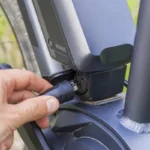If you’ve ever been on a golf course, you know that shanking the ball is one of the most frustrating experiences a golfer can have. From an embarrassing thwack off the toe of your club to an unexpected slice into a hazard, shanking can make even the most experienced golfers feel like they don’t belong on the green. But don’t worry—by understanding what causes shanks and how to stop shanking the golf ball, you can prevent them from happening in the future.
What is Shanking?
Shanking, or “heel-shanking” as it is sometimes called, occurs when you strike the ball with the heel of your club rather than its sweet spot. This typically happens when your swing path is too far inside. An excellent way to tell if this is happening is if you notice that your hands are close to your body at impact. If that doesn’t sound familiar, one sign of shanking could be that your ball curves are sharply right (right-handed golfers).

What Causes Shanks?
Grip Pressure
One of the most common causes of shanking is grip pressure. When gripping the club too tightly, players tend to tense up their arms and shoulders, often leading to an off-center hit. To avoid this, ensure your grip is relaxed to maintain a smooth swing throughout your entire round. It may feel counterintuitive initially. But if you practice enough, you will find that a softer grip often produces better results.
Swing Path
The path your club takes when swinging is essential to avoid a shank shot. If your swing path is too steep or too shallow, you will not only hit off-center shots more often than not. But you will also need to be more consistent with your accuracy. To ensure that you take the proper path with each swing, focus on keeping your shoulders level and making an even backswing and downswing motion throughout each shot. This will help keep your club in the correct position when hitting the ball and increase accuracy in the long run.
Club Face Position
The position of your club face when striking the ball is another factor that can cause shanks. If your club face is open or closed too much during impact, it can cause an unbalanced hit. Leading to a misdirection of where the ball goes after contact with the club head. Ensure that your club face is squared up properly. Before each swing, remain in this position from start to finish for the best results.
Read More: How To Hit The Golf Ball Straight?
How To Stop Shanking The Golf Ball?

The first step in dealing with a shank is understanding what causes it. For example, a common cause of shanking is poor alignment. If your feet are not lined up properly with the ball, you are more likely to hit it off-center.
Additionally, a false grip can lead to a shank—when your hands are too far up on the club or too far down. You won’t be able to control where the clubface contacts the ball. Therefore, it’s essential to make sure that your hands and feet are aligned correctly before you take each shot.
Another potential cause of shanking is a swing path that is too steep or flat. This can be caused by either having too much tension in your arms or not enough balance in your stance. Make sure you have relaxed arms and stay balanced throughout your swing. This will help ensure that you have a consistent swing path and don’t encounter any unwanted surprises at impact.
Finally, if you find yourself struggling with shanking, it might be time to invest in some lessons from a golf professional who can help diagnose what exactly is causing this issue and give you tips on how to correct it. In addition, a golf pro can provide insight into how your body moves during different parts of the swing. Moreover, which parts need improvement so that you can eliminate those pesky shanks once and for all?
Read More: What Golf Ball Should I Use?
Conclusion
We hope now you know how to stop shanking the golf ball. Shanking can be hugely frustrating for any golfer. But luckily it doesn’t have to be something that plagues your game forever. By improving your form and practicing regularly, you can start reducing those embarrassing shots off of tees and fairways alike!
So the next time you’re out on the course and think you might be in danger of shaking. Take some extra time with your setup and focus on keeping your hands behind the ball throughout your swing—you’ll thank yourself later!



